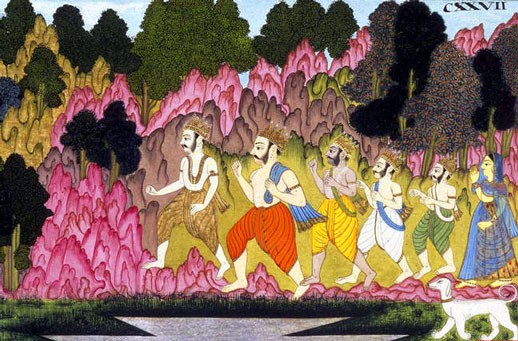
|
|
|
|
BY: SUN STAFF

The Pandavas in Exile Mar 15, 2013 — CANADA (SUN) — The Yadava dynasty's presence in Nepal, and the events that preceded and followed.
In the southeastern corner of Nepal is the ancient village of Buddhanagar, on the outskirts of what is now one of Nepal's influential cities -- Biratnagar. The city is named for King Birat, who is best known for having built a tall temple in Bihar, the Chandika Mata mandir. The Indian state of Bihar is Nepal's neighbor on its the southeast border, due north of Jharkhand.
Situated on the Gangetic plains, the fertile land of Bihar has been traversed since ancient times by those from northeast India heading up into Nepal and the Himalayas. Among the famous travelers on the route were the Pandavas, who crossed Bihar to enter Nepal at Buddhanagar.
Today, the city of Biratnagar is best known for being home to a number of large Nepal religious festivals, including Astami (Janmastami) and the annual Ratha Yatra, which is the city's biggest festival.
While Biratnagar draws thousands of visitors, it is the little known village of nearby Buddhanagar that represents the site of greatest historical importance to devotees. This is one of the sites where the five Pandava brothers took shelter after losing their kingdom in a dice game to their cousins, the Kauravas.
The famous dice game was arranged by the clever Shakuni (also known as Saubala). He was the brother of Gandhari and Duryodhana's maternal uncle. Credited as being a mastermind behind the Mahabharata war (by Krsna's arrangement), he endeared himself to the Kauravas, and especially Duryodhana. He worked his influence on Duryodhana and helped to incite the Pandavas to play the game of dice, knowing they would lose. The dice being used for the game were made from the bone of Shakuni's father's leg, and would thus listen to Shakuni's command. Knowing that if the game was lost, the Pandavas would inevitably have to fight the Kauravas, he arranged the game in order to get the Pandavas to fight, since they were the only ones who could put down the Kauravas. And destroying the Kauravas was Shakuni's deepest desire, in revenge of earlier wrongs committed against his family.
After losing the dice game, the Pandavas had to face 13 years of exile, one of them anonymous. While the Pandavas were roaming around in disguise to evade detection by their enemies, King Birat (Virat) engaged them in his service. During this period the Pandavas lived in the town of Virat Nagari.
The Mahabharata describes the Pandavas' disguises: Yudhishthir was a courtier who used to play Chaupar (dice) with the king; Bhima was a cook; Arjuna lived as Brihannala, the dance teacher of Uttara, King Virat's daughter who later married Abhimanyu. Draupadi was disguised as a maid to the queen. The Queen's brother, Keechak tried to lure Draupadi and was thus killed by Bhima near a pond, known today as Dhupakali Pond. The city of Virat Nagari is now known as Rath.
King Birat's capital city at Biratnagar is adjacent to the Jhapa district, where there is a place called Kichakbadh, where these pastimes of the Pandavas took place.
In the case of Buddhanagar, Nepal, the significance of the place in the Mahabharata Period was long a well known local legend, but with little evidence in hand to prove it. Then, in the 1960's, the area was excavated. A representative of the office of Archaeological Survey of Nepal (ASN) stated:
"The ruins of a temple were found under a mound. Its unusual elliptical design points to it having been constructed possibly around 1st Century BC during the reign of the Sunga kings."
The excavation also yielded a cache of silver bars with various signs that the ASN says were used as coins and statues.
Buddhanagar's historical importance was unknown to the local government officials until the Koirala government in 2006 began plans to build a dry port in the area. Then local villagers sent out an urgent plea for help to the ASN, who put a stop to the construction work and made plans for a formal survey of the site. Because Buddhanagar is in Nepal, but right on the border of India, it was hoped that the ASN and the ASI would engage in a joint study.
Sadly, in 1993 a fire destroyed both the records of the initial excavation and the found artifacts. The government of Nepal, beseiged with political instability and a shortage of funds by that time was not in a position to push the archeological survey forward. However, the local Maoists guerrillas have continued to try and draw attention to the historical heritage.
| |